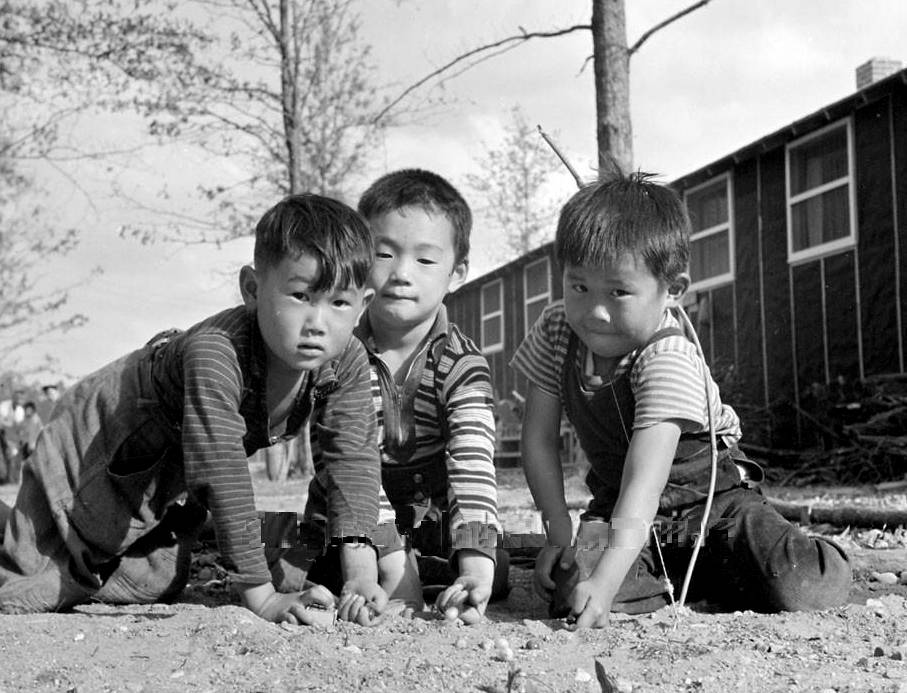
Internment of Japanese Americans: The Children

Figure 1.--Here some younger Japanese-American children enjoy a gamne of marbles in 1942 shortly after arriving at their relocation camp. It was a camp in Arkansas. Notice the new tar paper barracks in the background. One thing about the camps for the children was there was never a shortage of playmates. Notice the boy oin the right is prepared for some serious play he has an archery bow.
|
|
Juveniles composed more than half of the 120,000 Japanese Americans interned in camps during World War II. We are not entirely sure just how they were affected. The children clearly had less comfortable childhoods than they woukd hve had. They were taken away from comfortables homes and lived in drafty, barren barracks. As far as we know, howver, there were no health consequences. They were adequately clothed and fed. In fact the food at the camps was better than what many American families endured during the Depression. As far as we know there was no weight loss orr negative growth consequences. These are physical attributes that can be measured. There may have been long-term heakth consequences. Accordingto one report, "Survey information found former internees had a 2.1 greater risk of cardiovascular disease, cardiovascular mortality, and premature death than did a non-interned counterpart. California Nisei-age individuals, the proxy for internment, died 1.6 years earlier than Hawaiians who represented non-interned status. I concluded traumatic stress has life-long consequences even in the presence of efficacious coping strategies." [Jensen] Apparently the stress experienced had health consequences. I do not know if other researchers have confirmed this observation. The children y attended local schools so their education was not interupted unless they were of university age. We do not know to what extent the internment was discussed in classes or on the playground. Another question is the psycological impact. Some authors have mentioned a loss of self esteem. The younger children may not have fully understiod what was happening, but the olfer children certainly did. One authorwrites, "Trauma may directly or indirectly affect the children of trauma victims. The multiple pathways of its effects create a variety of consequences. Despite the silence, or perhaps because of it, the Sansei who had a parent interned felt the effects of that experience in numerous ways. They are sad and angry about the injustice and attribute a number of negative consequences in their own lives to their parents' internment. These include feelings of low self-esteem, the pressure to assimilate, an accelerated loss of the Japanese culture and language, and experiencing the unexpressed pain of their parents." {Nagata] One can certainly see how the oldr children and teenagers may have experiebced aoss of seld esteem in that they were being so obviously treated as second class citizens. Psycological impacts are, however, very difficult to sess and measure. There is no evidence that the experience affected school performance, although I supose onc could argue that the children may have performned even better if they had not been interned. We get the impression that researchers out of sympathy seem to what to find adverse impactsand are disappointed that they have been unabke to do so. Of course thecchikdren were adversely impacted by the financial losses their parents experienced when shops, g=farms, anbd himes had to be sold on short notice. Only this was more thn compensatd by the fact that following the war, the job market was thrown wide open. And thus Japanese Americans who previously found getting into collge and universities difficult and obtaining jobs in government and industry virtually impossible, sudenly found unwritten racial barriers evaporating. There appear to have been some sociolgical consequences. Although not separated from their parents, Japanese Americans in Pacific coast states were interned in concentration or relocation camps as they were called. One impact on the children was that the very-close knit family life characteristic of Japanese families were weakened. The camps were organized on a communal basis. This included meals. Thus families no longer set down in their own homes for meals. Children especially teenagers began spending more times with friends rather than with their family. The strong parental authority common before the War was weakened. This to an extent probably promoted assimilation.
Sources
Jensen, Gwendolyn M. The Experience of Injustice: Health Consequences of the Japanese American Internment (1997).
Nagata, Donna K. Legacy of Injustice: Exploring the Cross-Generational Impact of the Japanese American Internment (1993).
HBC

Navigate the Boys' Historical Clothing Web Site:
[Return to World War II interment of Japanse-Americans ]
[Return to Main American 1940s page]
[Return to Main World War II page]
[Introduction]
[Activities]
[Biographies]
[Chronology]
[Clothing styles]
[Countries]
[Bibliographies]
[Contributions]
[FAQs]
[Glossaries]
[Images]
[Links]
[Registration]
[Tools]
[Boys' Clothing Home]
Created: 6:25 AM 5/24/2012
Last updated: 6:25 AM 5/24/2012



